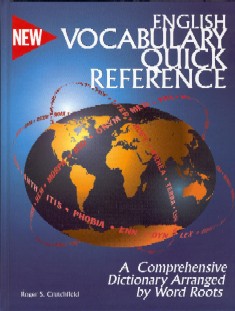HOW TO
USE THIS BOOK
The Vocabulary Quick
Reference begins with a primary root index that lists 260 word roots. All
prefixes and suffixes are considered to be roots. They are simply roots
that occur at the beginning or end of a word. Each root in this section is
followed by a page number that indicates the page in the dictionary
section where the root can be found.
In the dictionary section,
each root is followed by a comprehensive list of words that contain that
root. The number of words following each root varies and is limited to
those words found in a standard desk dictionary such as Webster's New
World, American Heritage, or Webster's 10th New Collegiate. The words in
the lists that follow each root are referred to as main entries. If a main
entry contains more than one primary root, that main entry appears in more
than one list. The secondary root index in the last section of the book
includes a list of over 500 additional roots for which no lists were made.
These are generally less common roots, but still very important to the
etymology of the main entries in the dictionary section.
For each main entry in the
dictionary section, the etymology follows the word and the definition
follows the etymology. The pronunciation is located after the definition.
If the main entry is in red, it was found in
a student dictionary such as Webster's High School Dictionary,
Thorndike-Barnhart Student Dictionary, or Macmillan's Dictionary for
Students and is therefore considered to be a very common word. The main
entries in red are very likely to appear on
the SAT and other college entrance exams.
The words in blue within
each definition are called keywords because they are the most important
part of the definition. They are essentially a shorter definition imbedded
within the complete definition. These keywords in blue are compiled into a
long alphabetical list that comprises the keyword section of the
Vocabulary Quick Reference. This comprehensive list of keywords brings the
meanings of all the main entries in the dictionary section into one list
that groups many related words together.
The red keywords in the
keyword section correspond to the red main entries in the dictionary
section. If the main entry was red in the dictionary section, its keywords
will be red in the keywords section. This is to enable the user to easily
pick out the more common words while reading through the keyword section.
The main entry index lists
all the main entries and the page numbers they appear on in the dictionary
section. This list can be used when the user knows the word to be looked
up and just needs the page number.
Braces { } are used in the
dictionary section to indicate a short definition or explanation for the
preceding word or syllable. See decare on page 163 and the pronunciation
for regress on page 97.
Colored tabs are provided
for quick access to the dictionary, keywords, and main entry index
sections.
The introduction to the
Vocabulary Quick Reference appears on page i and the pronunciation key
appears on page iv.













